Emission Characteristics of Hazardous Air Pollutants from Medium-Duty Diesel Trucks Based on Driving Cycles
Abstract
:1. Introduction
2. Materials and Methods
2.1. Test Vehicle and Fuel
2.2. Test Cycles
2.3. Measuring Instruments and Test Method
2.3.1. Chassis Dynamometer Emission Measurement System
2.3.2. Analysis Method for HAPs
3. Results and Discussion
3.1. Emission Characteristics of Regulated Pollutants
3.2. Emission Characteristics of HAPs
3.3. Speciation of HAPs and Selection of Priority Management Pollutants
4. Conclusions
Author Contributions
Funding
Institutional Review Board Statement
Informed Consent Statement
Data Availability Statement
Conflicts of Interest
Abbreviations
| HAPs | hazardous air pollutants |
| VOCs | volatile organic compounds |
| PAHs | polycyclic aromatic hydrocarbons |
| NMHC | non-methane hydrocarbon |
| WLTC | worldwide harmonized light duty driving test cycle |
| NEDC | new European driving cycle |
| CVS | constant volume sampler |
| NIER | National Institute of Environmental Research |
| NMVOC | non-methane volatile organic compound |
| SMA | Seoul Metropolitan Area |
| TEQ | toxic equivalency quantity |
| DPF | diesel particulate filter |
| SCR | selective catalytic reduction |
| DOC | diesel oxidation catalysts |
| EGR | exhaust gas recirculation |
| LNT | lean NOx trap |
| UDC | urban driving cycle |
| EUDC | extra-urban driving cycle |
| FTP | federal test procedure |
| NDIR | nondispersive infrared |
| THC | total hydrocarbons |
| HFID | heated flame ionization detector |
| CLD | chemiluminescence detector |
| PN | particle number |
| KP | gas–particle partition coefficient (μg/m3) |
| TSP | concentration of total suspended particulate material (μg/m3) |
| F | particle phase concentration of PAHs (μg/m3) |
| A | gaseous phase concentration of PAHs (μg/m3) |
| TEF | toxicity equivalent factor |
| EEA | European Environmental Agency |
References
- Ministry of Land, Transport, Maritime Affairs (MLTMA). Automobile Registration Statistics (2019); Ministry of Land, Transport, Maritime Affairs: Sejong, Korea, 2020. [Google Scholar]
- National Center for Fine Dust Information (NCFDI). National Air Pollutant Emission Service. Available online: http://airemiss.nier.go.kr (accessed on 20 March 2021).
- National Institute of Environmental Research (NIER). Study on Emission Characteristics of Hazardous Air Pollutants in Vehicle; National Institute of Environmental Research: Incheon, Korea, 2018. [Google Scholar]
- Jung, S.; Lim, J.; Kwon, S.; Jeon, S.; Kim, J.; Lee, J.; Kim, S. Characterization of particulate matter from diesel passenger cars tested on chassis dynamometers. J. Environ. Sci. 2017, 54, 21–32. [Google Scholar] [CrossRef]
- National Institute of Environmental Research (NIER). A Study on the Estimation of the HAPs Emission Factors for the Mobile Source (Ⅲ); National Institute of Environmental Research: Incheon, Korea, 2006. [Google Scholar]
- National Institute of Environmental Research (NIER). The Emission Characteristics of Mobile Source Air Toxics and Management Strategy (IV); National Institute of Environmental Research: Incheon, Korea, 2017. [Google Scholar]
- Kumar, S.; Nayek, M.; Tandon, A.; Mondal, P.; Vijay, P.; Bhangale, U.D.; Tyagi, D. Aldehyde, Ketone and Methane Emissions from Motor Vehicle Exhaust: A Critical Review. Am. Chem. Sci. J. 2011, 1, 1–27. [Google Scholar] [CrossRef] [Green Version]
- Han, J.-S.; Lee, M.-D.; Lim, Y.-J.; Lee, S.-U.; Kim, Y.-M.; Kong, B.-J.; An, J.-Y.; Hong, Y.-D. Study on the distributions of VOCs, aldehydes, PAHs concentration in Seoul metropolitan area. J. Korean Soc. Atmos. Environ. 2006, 22, 574–589. [Google Scholar]
- Wang, J.; Jin, L.; Gao, J.; Shi, J.; Zhao, Y.; Liu, S.; Jin, T.; Bai, Z.; Wu, C.-Y. Investigation of speciated VOC in gasoline vehicular exhaust under ECE and EUDC test cycles. Sci. Total Environ. 2013, 445–446, 110–116. [Google Scholar] [CrossRef]
- Costagliola, M.A.; Murena, F.; Prati, M.V. Exhaust emissions of volatile organic compounds of powered two-wheelers: Effect of cold start and vehicle speed. Contribution to greenhouse effect and tropospheric ozone formation. Sci. Total Environ. 2014, 468–469, 1043–1049. [Google Scholar] [CrossRef] [PubMed]
- Li, L.; Ge, Y.; Wang, M.; Li, J.; Peng, Z.; Song, Y.; Zhang, L. Effect of gasoline/methanol blends on motorcycle emissions: Exhaust and evaporative emissions. Atmos. Environ. 2015, 102, 79–85. [Google Scholar] [CrossRef]
- Pěnčíková, K.; Ciganek, M.; Neča, J.; Illés, P.; Dvořák, Z.; Vondráček, J.; Machala, M. Modulation of endocrine nuclear receptor activities by polyaromatic compounds present in fractionated extracts of diesel exhaust particles. Sci. Total Environ. 2019, 677, 626–636. [Google Scholar] [CrossRef]
- Lim, J.; Lim, C.; Kim, S.; Hong, J. Characterizations of organic compounds in diesel exhaust particulates. J. Environ. Sci. 2015, 34, 171–183. [Google Scholar] [CrossRef]
- Zhang, Z.; Balasubramanian, R. Effects of oxygenated fuel blends on the composition of size-segregated engine-out diesel particulate emissions and on the toxicity of quasi-ultrafine particles. Fuel 2018, 215, 161–170. [Google Scholar] [CrossRef]
- Zhou, S.; Zhou, J.; Zhu, Y. Chemical composition and size distribution of particulate matters from marine diesel engines with different fuel oils. Fuel 2019, 235, 972–983. [Google Scholar] [CrossRef]
- Jung, S.; Mun, S.; Chung, T.; Kim, S.; Seo, S.; Kim, I.; Hong, H.; Chong, H.; Sung, K.; Kim, J.; et al. Emission Characteristics of Regulated and Unregulated Air Pollutants from Heavy Duty Diesel Trucks and Buses. Aerosol Air Qual. Res. 2019, 19, 431–442. [Google Scholar] [CrossRef]
- Jung, S.; Kim, S.; Lim, Y.; Lee, J.; Chung, T.; Hong, H.; Mun, S.; Lee, S.; Jang, W.; Lim, J. Emission Characteristics of Hazardous Air Pollutants from Construction Equipment. Aerosol Air Qual. Res. 2020, 20, 2012–2024. [Google Scholar] [CrossRef]
- Lim, J.; Lim, C.; Jung, S. Characterizations of Size-segregated Ultrafine Particles in Diesel Exhaust. Aerosol Air Qual. Res. 2021, 21, 21. [Google Scholar] [CrossRef]
- Dong, D.; Shao, M.; Li, Y.; Lu, S.; Wang, Y.; Ji, Z.; Tang, D. Carbonyl emissions from heavy-duty diesel vehicle exhaust in China and the contribution to ozone formation potential. J. Environ. Sci. 2014, 26, 122–128. [Google Scholar] [CrossRef]
- George, I.J.; Hays, M.D.; Snow, R.; Faircloth, J.; George, B.J.; Long, T.; Baldauf, R.W. Cold Temperature and Biodiesel Fuel Effects on Speciated Emissions of Volatile Organic Compounds from Diesel Trucks. Environ. Sci. Technol. 2014, 48, 14782–14789. [Google Scholar] [CrossRef]
- Nelson, P.F.; Tibbett, A.R.; Day, S.J. Effects of vehicle type and fuel quality on real world toxic emissions from diesel vehicles. Atmos. Environ. 2008, 42, 5291–5303. [Google Scholar] [CrossRef]
- Hu, S.; Herner, J.D.; Robertson, W.; Kobayashi, R.; Chang, M.-C.O.; Huang, S.-M.; Zielinska, B.; Kado, N.; Collins, J.F.; Rieger, P.; et al. Emissions of polycyclic aromatic hydrocarbons (PAHs) and nitro-PAHs from heavy-duty diesel vehicles with DPF and SCR. J. Air Waste Manag. Assoc. 2013, 63, 984–996. [Google Scholar] [CrossRef] [Green Version]
- Li, G.; Ji, F.; Bai, X.; Zhou, Y.; Dong, R.; Huang, Z. Comparative study on thermal cracking characteristics and bio-oil production from different microalgae using Py-GC/MS. Int. J. Agric. Biol. Eng. 2019, 12, 208–213. [Google Scholar] [CrossRef]
- Li, G.; Bai, X.; Huo, S.; Huang, Z. Fast pyrolysis of LERDADEs for renewable biofuels. IET Renew. Power Gener. 2020, 14, 959–967. [Google Scholar] [CrossRef]
- Korea Automobile Manufacturers Association (KAMA). Automobile Registration Statistics (2019); KAMA: Seoul, Korea, 2020. [Google Scholar]
- United States Environmental Protection Agency (US EPA). Determination of Volatile Organic Compounds (VOCs) in Ambient Air Using Specially Prepared Canisters with Subsequent Analysis by Gas Chromatography, Method TO-14A; Environmental Protection Agency: Washington, DC, USA, 1999. [Google Scholar]
- United States Environmental Protection Agency (US EPA). Determination of Formaldehyde in Ambient Air Using Adsorbent Cartridge Followed by High Performance Liquid Chromatography (HPLC), Method TO-11A; Environmental Protection Agency: Washington, DC, USA, 1999.
- United States Environmental Protection Agency (US EPA). Determination of Polycyclic Aromatic Hydrocarbons (PAHs) in Ambient Air Using Gas Chromatography/Mass Spectrometry (GC/MS), Method TO-13A; Environmental Protection Agency: Washington, DC, USA, 1999.
- National Institute of Environmental Research (NIER). The Emission Characteristics of Mobile Source Air Toxics and Management Strategy (V); National Institute of Environmental Research: Incheon, Korea, 2018.
- Hong, H.; Mun, S.; Seo, S.; Kim, J.; Jung, S.; Chung, T.; Hong, Y.; Sung, K.; Kim, S. Emission Characteristics of Hazardous Air Pollutants from Diesel Heavy Duty Trucks for Euro 5. J. Liq. At. Spray Syst. 2018, 23, 74–80. [Google Scholar]
- Knafl, A.; Busch, S.B.; Han, M.; Bohac, S.V.; Assanis, D.N.; Szymkowicz, P.G.; Blint, R.J. Characterizing Light-Off Behavior and Species-Resolved Conversion Efficiencies During In-Situ Diesel Oxidation Catalyst Degreening. SAE Tech. Paper Ser. 2006, 53–62. [Google Scholar] [CrossRef]
- Bohac, S.V.; Han, M.; Jacobs, T.J.; López, A.J.; Assanis, D.N.; Szymkowicz, P.G. Speciated Hydrocarbon Emissions from an Automotive Diesel Engine and DOC Utilizing Conventional and PCI Combustion. SAE Tech. Paper Ser. 2006, 41–52. [Google Scholar] [CrossRef]
- Yao, Z.; Jiang, X.; Shen, X.; Ye, Y.; Cao, X.; Zhang, Y.; He, K. On-Road Emission Characteristics of Carbonyl Compounds for Heavy-Duty Diesel Trucks. Aerosol Air Qual. Res. 2015, 15, 915–925. [Google Scholar] [CrossRef] [Green Version]
- Akyüz, M.; Çabuk, H. Gas–particle partitioning and seasonal variation of polycyclic aromatic hydrocarbons in the atmosphere of Zonguldak, Turkey. Sci. Total Environ. 2010, 408, 5550–5558. [Google Scholar] [CrossRef] [PubMed]
- Yamasaki, H.; Kuwata, K.; Miyamoto, H. Effects of ambient temperature on aspects of airborne polycyclic aromatic hydrocarbons. Environ. Sci. Technol. 1982, 16, 189–194. [Google Scholar] [CrossRef]
- Pankow, J.F. Review and comparative analysis of the theories on partitioning between the gas and aerosol particulate phases in the atmosphere. Atmos. Environ. 1987, 21, 2275–2283. [Google Scholar] [CrossRef]
- Pankow, J.F.; Bidleman, T. Effects of temperature, TSP and per cent non-exchangeable material in determining the gas-particle partitioning of organic compounds. Atmos. Environ. Part A Gen. Top. 1991, 25, 2241–2249. [Google Scholar] [CrossRef]
- Pankow, J.F.; Bidleman, T.F. Interdependence of the slopes and intercepts from log-log correlations of measured gas-particle partitioning and vapor pressure-I. Theory and analysis of available data. Atmos. Environ. 1992, 26, 1071–1080. [Google Scholar] [CrossRef]
- Volckens, J.; Leith, D. Comparison of methods for measuring gas-particle partitioning of semivolatile compounds. Atmos. Environ. 2003, 37, 3177–3188. [Google Scholar] [CrossRef]
- Catino, S.; Tutino, M.; Ruggieri, S.; Marinaccio, C.; Giua, R.; De Gennaro, G.; Corsi, P.; Assennato, G.; Ribatti, D. Angiogenic activity in vivo of the particulate matter (PM10). Ecotoxicol. Environ. Saf. 2017, 140, 156–161. [Google Scholar] [CrossRef]
- Tan, P.-Q.; Zhong, Y.-M.; Hu, Z.-Y.; Lou, D.-M. Size distributions, PAHs and inorganic ions of exhaust particles from a heavy duty diesel engine using B20 biodiesel with different exhaust aftertreatments. Energy 2017, 141, 898–906. [Google Scholar] [CrossRef]
- Upham, B.L.; Weis, L.M.; Trosko, J.E. Modulated gap junctional intercellular communication as a biomarker of PAH epigenetic toxicity: Structure-function relationship. Environ. Health Perspect. 1998, 106, 975–981. [Google Scholar] [CrossRef] [PubMed]
- Rummel, A.M.; Trosko, J.E.; Wilson, M.R.; Upham, B. Polycyclic aromatic hydrocarbons with bay-like regions inhibited gap junctional intercellular communication and stimulated MAPK activity. Toxicol. Sci. 1999, 49, 232–240. [Google Scholar] [CrossRef] [Green Version]
- Catterall, F.S.; Coombs, M.M.; Ioannides, C.; Sepiol, J.J.; Wilson, J. Mutagenicity of bay-region amino-substituted cyclopenta[a]phenanthrenes and 2- and 5-aminochrysene. Mutat. Res. Toxicol. Environ. Mutagen. 2001, 492, 7–11. [Google Scholar] [CrossRef]
- Jiang, Y.; Yang, J.; Cocker, D.; Karavalakis, G.; Johnson, K.C.; Durbin, T.D. Characterizing emission rates of regulated pollutants from model year 2012 + heavy-duty diesel vehicles equipped with DPF and SCR systems. Sci. Total Environ. 2018, 619-620, 765–771. [Google Scholar] [CrossRef] [Green Version]
- Ntziachristos, L.; Samaras, Z.; Kouridis, C. EMEP/EEA Air Pollutant Emission Inventory Guidebook 2016, European Environ Agency. 2017. Available online: https//www.eea.Eur.eu/themes/air/emep-eea-air-pollutant-emission-inventory-guidebook/emep (accessed on 14 December 2018).
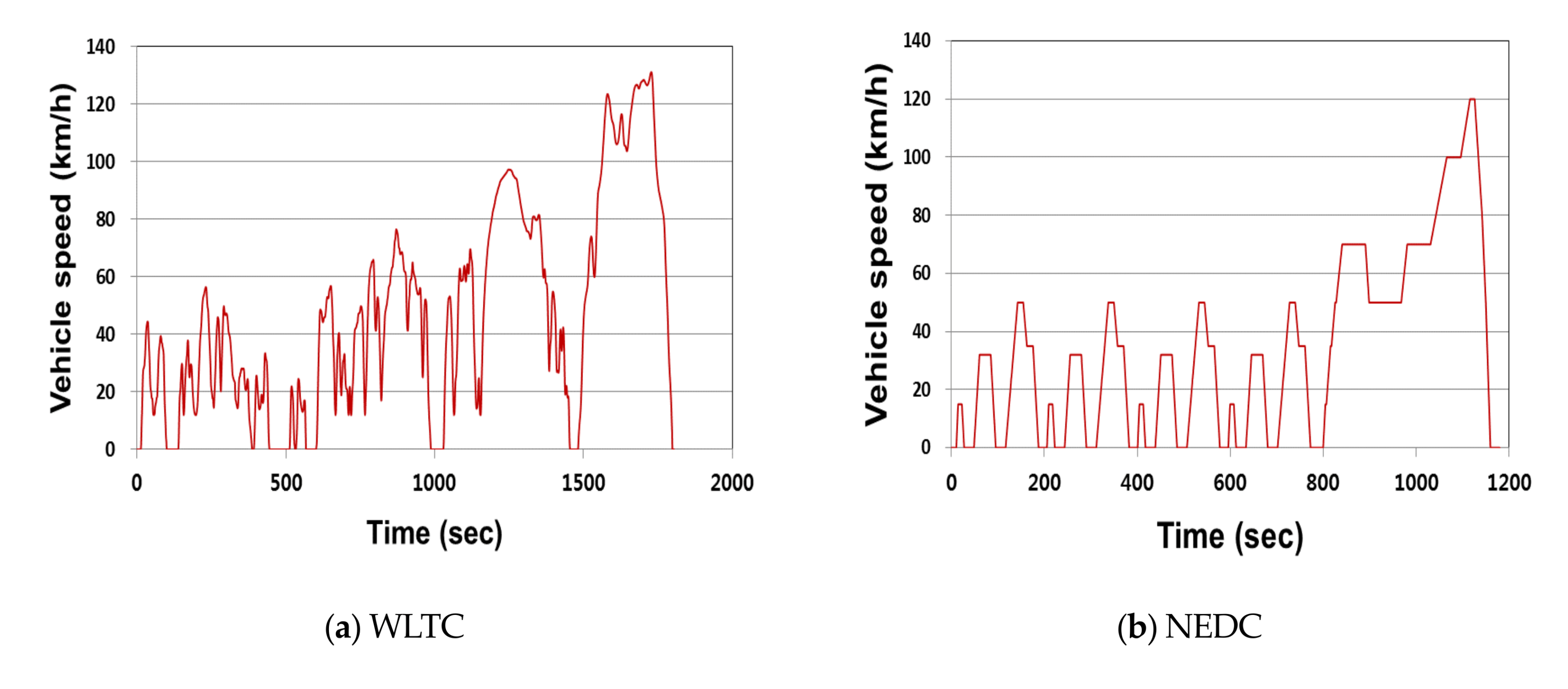
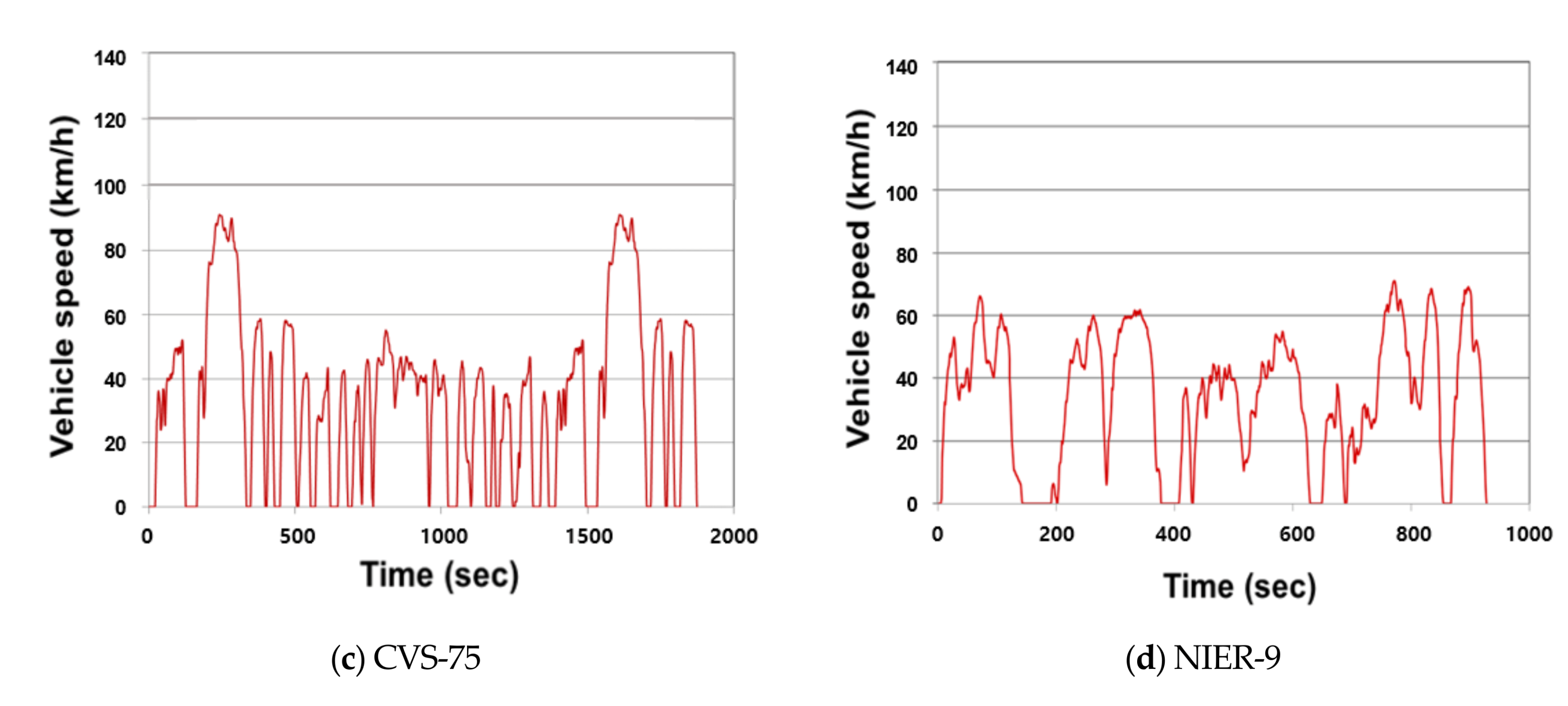

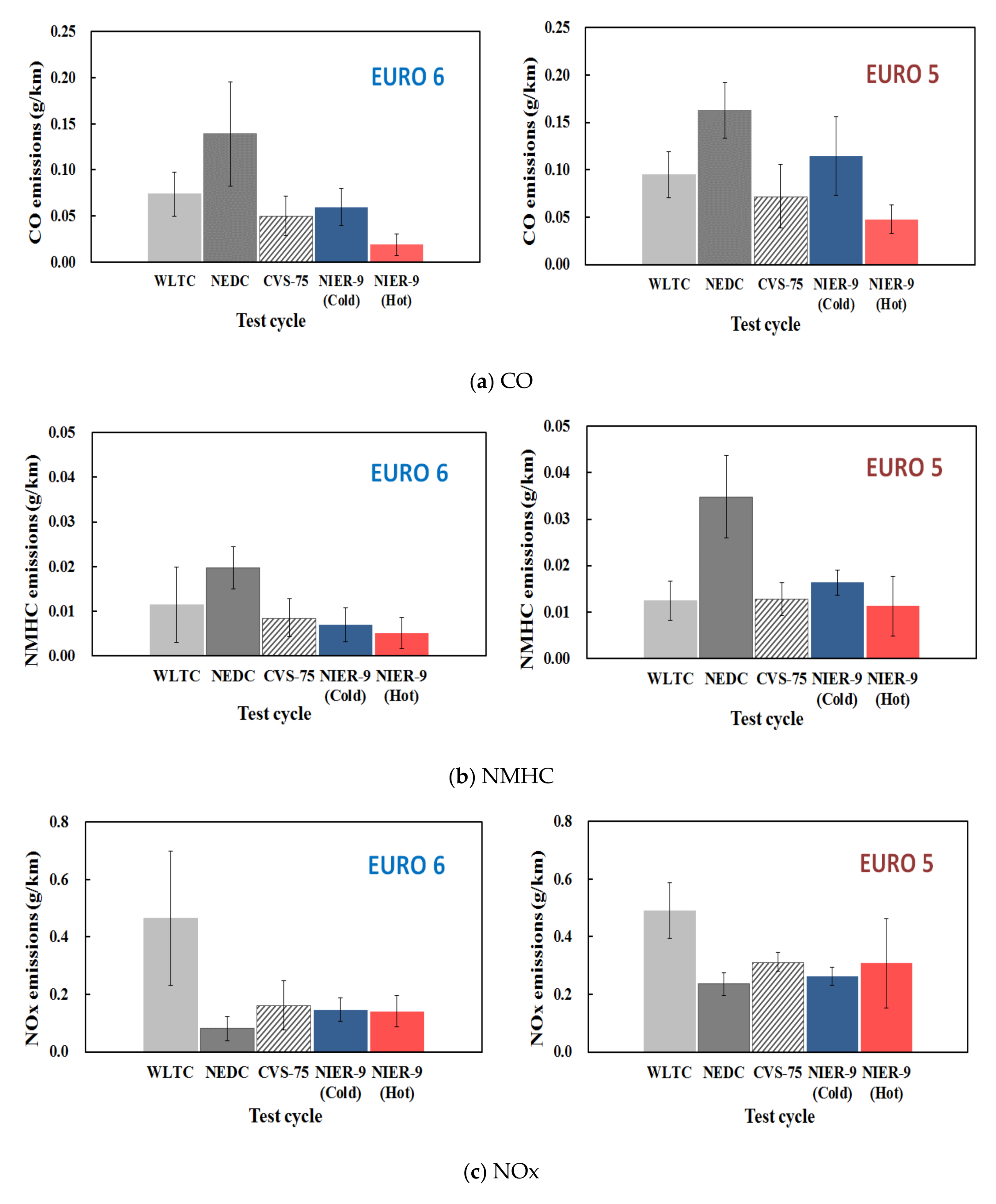


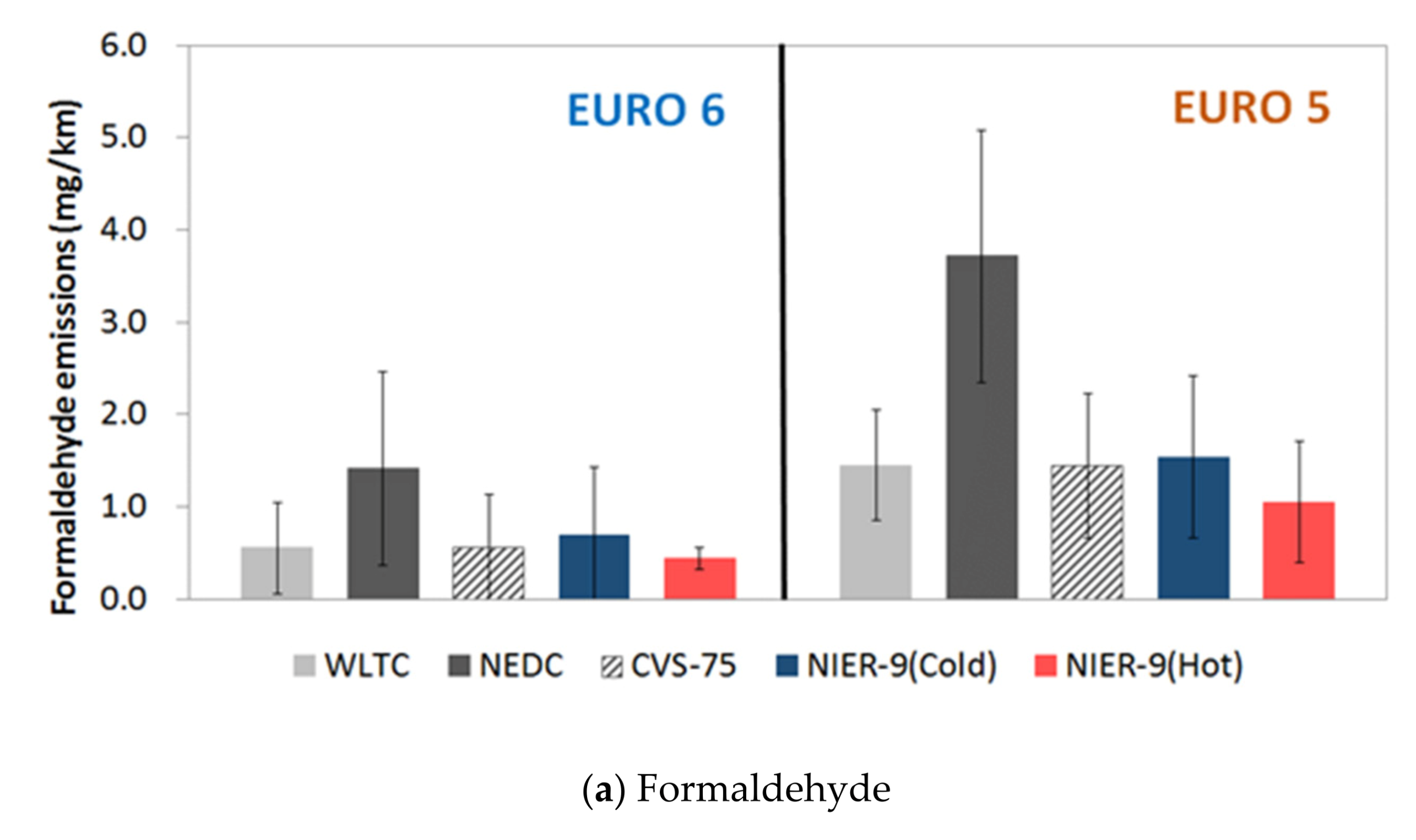
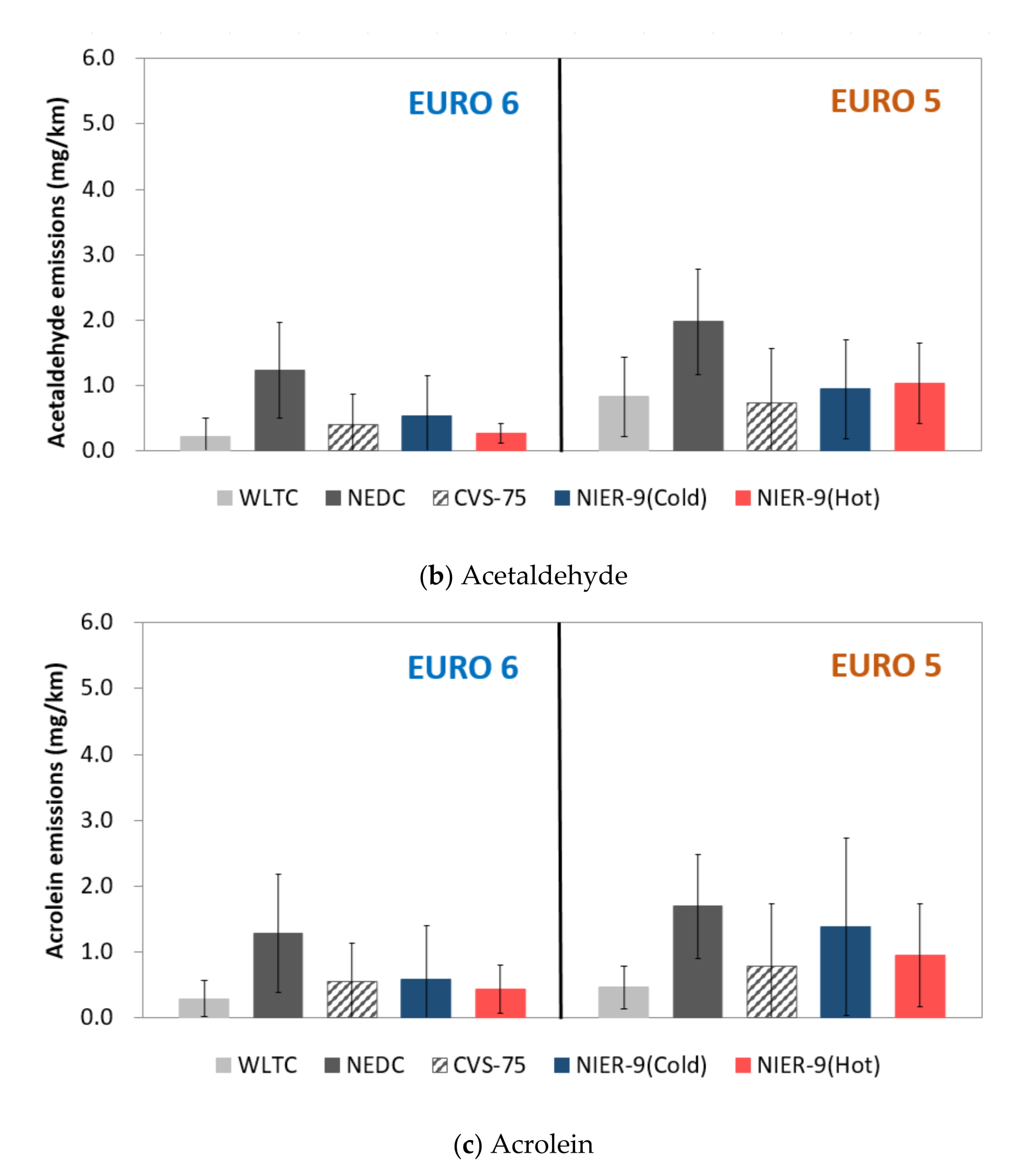
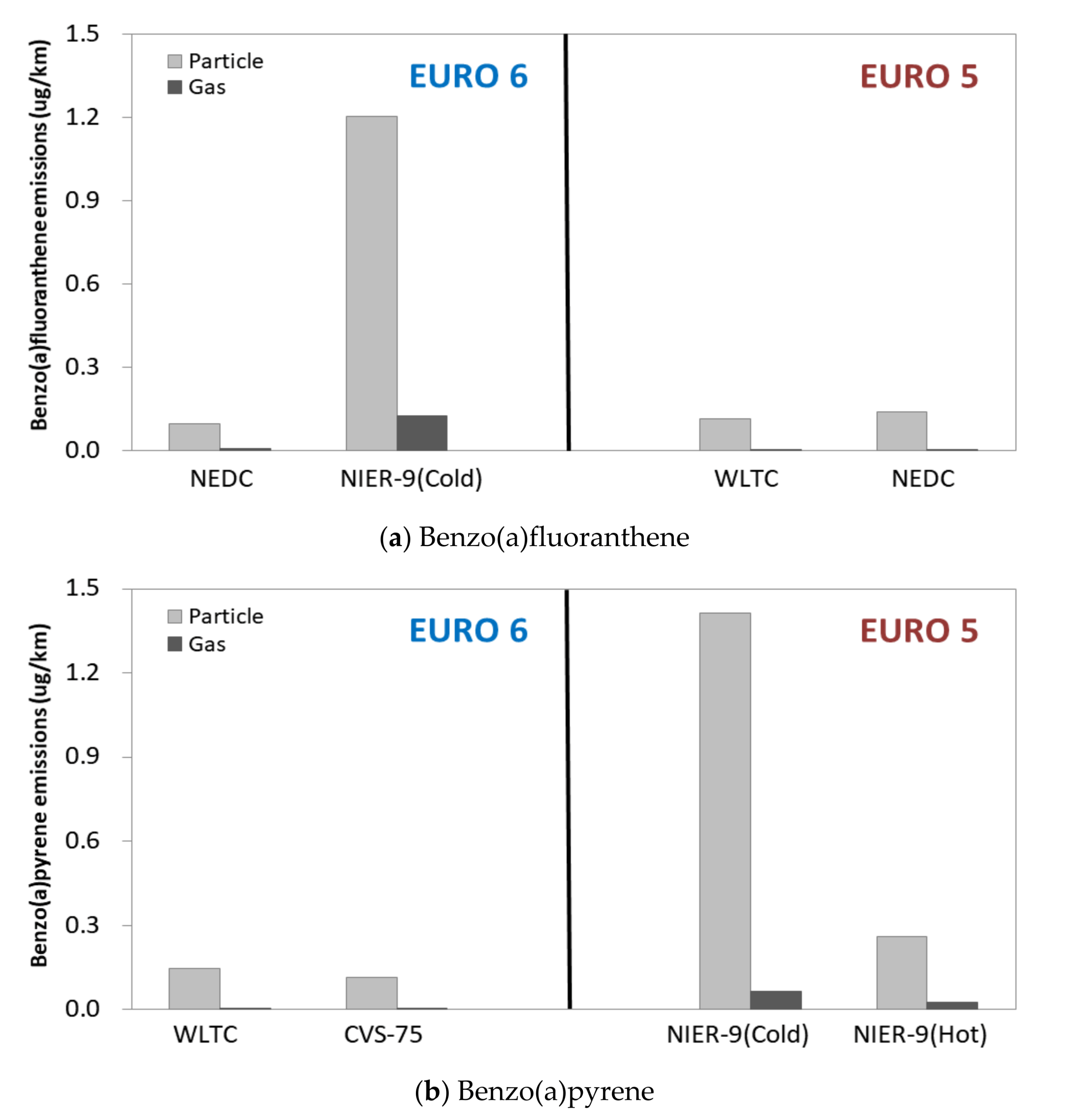
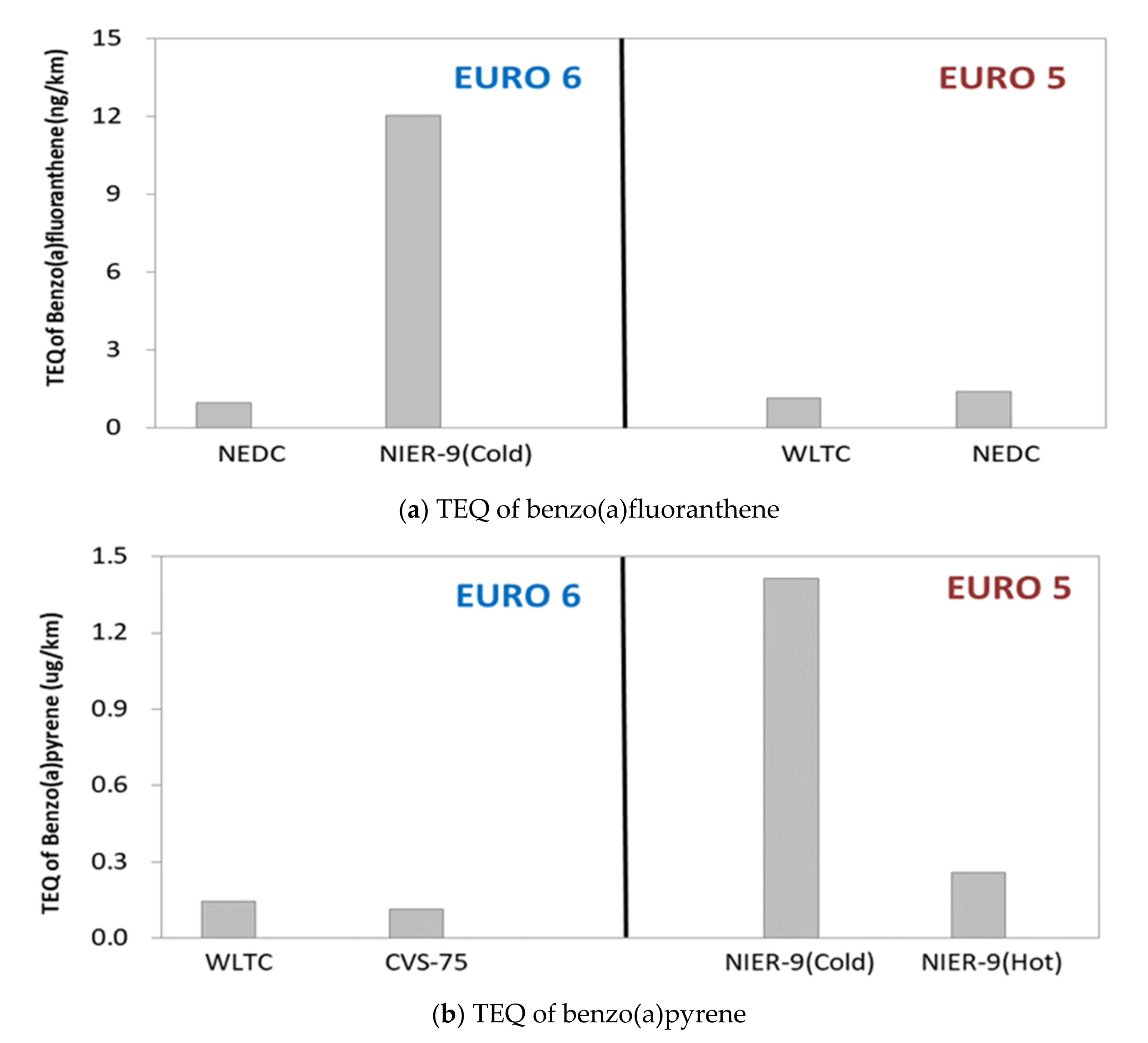
| Vehicle Type | Fuel Type | Maker | Displace-ment (cc) | GVW (kg) | Max Power (ps/rpm) | After-Treatment System a | Emission Standards |
|---|---|---|---|---|---|---|---|
| Medium-duty truck | Diesel | Hyundai | 2497 | 2975 | 133/3600 | DPF + LNT | Euro 6 |
| Hyundai | 2497 | 2915 | 133/3800 | ||||
| Hyundai | 2497 | 2945 | 133/3600 | ||||
| Hyundai | 2497 | 3200 | 133/3800 | ||||
| KIA | 2497 | 2985 | 133/3600 | ||||
| Hyundai | 2497 | 3200 | 133/3800 | DPF | Euro 5 | ||
| KIA | 2497 | 2895 | 133/3800 | ||||
| KIA | 2497 | 2985 | 133/3600 | ||||
| SSangyong | 1998 | 2720 | 155/4000 | ||||
| SSangyong | 1998 | 2720 | 155/4000 |
| Properties | Result | Standards b |
|---|---|---|
| Residual carbon content/10% residual oil (wt %) | 0.01 | ≤0.15 |
| Density (15 °C, kg/m3) | 824 | 815–835 |
| Sulfur content (ppm) | 7 | ≤10 |
| PAHs a (wt %) | 2 | ≤5 |
| Lubrication (μm) | 292 | ≤400 |
| Aromatic compounds (wt %) | 21 | ≤30 |
| Cetane index (or Cetane number) | 55 | ≥52 |
| Driving Cycle | Driving Time (s) | Driving Distance (km) | Average Speed (km/h) | Maximum Speed (km/h) |
|---|---|---|---|---|
| WLTC | 1800 | 23.25 | 46.4 | 131.3 |
| NEDC | 1180 | 10.93 | 33.4 | 120.0 |
| CVS-75 | 1874 | 17.77 | 36.1 | 91.2 |
| NIER-9 | 926 | 8.76 | 34.1 | 70.9 |
| Pollutant | Measuring Method | Measuring Conc. Range |
|---|---|---|
| CO | NDIR b | 50, 100, 300, 3000 ppm |
| THC a | HFID c | 20, 50, 100, 200 ppmC e |
| NOx | CLD d | 20, 50, 100, 1000 ppm |
| CO2 | NDIR b | 1, 2, 3, 6% |
| CH4 | HFID c | 10, 20, 50 ppm |
| Method | EPA TO-14A | ||||
|---|---|---|---|---|---|
| Thermaldesorber | Model | Markes International/Unity2 | |||
| Purge | Prepurge time (mL/min) | 1 | |||
| Trap prepurge time (mL/min) | 1 | ||||
| Sample | Sampling time (min) | 10 | |||
| Sample flow rate (mL/min) | 20 | ||||
| Trap desorber | Trap low temp. (°C) | −15 | |||
| Trap high temp. (°C) | 300 | ||||
| Trap hold time (min) | 5 | ||||
| Split flow (mL/min) | 30 | ||||
| GC/MS | Model | Agilent 7890B/Almsco BenchTOF-Select | |||
| Column | DB-1 (60 m × 0.32 mm × 3.00 μm) | ||||
| Column temp. | Temp. (°C) | Rate (°C/min) | Hold time (min) | Total time (min) | |
| 30 | 0.0 | 30.00 | 30.00 | ||
| 150 | 5.0 | 10.00 | 64.00 | ||
| 200 | 15.0 | 10.00 | 77.33 | ||
| Transfer line temp. | 200 | ||||
| Ion source temp. | 200 | ||||
| Electron energy | 70 eV | ||||
| Ionization mode | EI | ||||
| MS scan range | 35–350 amu | ||||
| Method | EPA TO-11A | |||
|---|---|---|---|---|
| Model | Waters US/ACOUITY UPLC | |||
| Detector | TUV, 360 nm | |||
| Column | ACQUITY UPLC™ BEH C18 1.7 μm 2.1 × 100 mm | |||
| Mobile phase | Solvent A: 90% water + 10% tetrahydrofuran (THF) Solvent B: 100% acetonitrile (ACN) | |||
| Gradient | Time (min) | Flow (mL/min) | A(%) | B(%) |
| Initial | 0.3 | 60 | 40 | |
| 5.0 | 0.3 | 60 | 40 | |
| 10.0 | 0.3 | 0 | 100 | |
| 12.0 | 0.3 | 60 | 40 | |
| 15.0 | 0.3 | 60 | 40 | |
| Flow rate | 0.3 mL/min | |||
| Injection volume | 2 μL | |||
| Method | EPA TO-13A | |||
|---|---|---|---|---|
| Model | Agilent 7890A/Almsco Bench TOF-dx | |||
| Column | HP-5MS (30 m × 0.25 mm × 0.25 μm) | |||
| Column temp. | Temp (°C) | Rate (°C/min) | Hold time (min) | Total time (min) |
| 50 | 1 | 1 | ||
| 180 | 8 | 0 | 17.25 | |
| 240 | 5 | 0 | 29.25 | |
| 300 | 10 | 10 | 45.25 | |
| Column flow | 1 mL/min | |||
| Inlet heater | 300 °C | |||
| Split ratio | 10:1 | |||
| Injection volume | 1 μL | |||
| Transfer line | 300 °C | |||
| Ion source | 250 °C | |||
| MS san range | 100–300 amu | |||
| Euro 6 (Unit: mg/km) | ||||||||||
|---|---|---|---|---|---|---|---|---|---|---|
| No. | WLTC | NEDC | CVS-75 | NIER-9(Cold) | NIER-9(Hot) | |||||
| 1 | Benzene | 0.51 ± 0.53 | Benzene | 0.91 ± 1.64 | Benzene | 0.19 ± 0.22 | Dodecane | 1.72 ± 1.53 | Benzene | 1.01 ± 1.04 |
| 2 | Dodecane | 0.24 ± 0.32 | Propylene | 0.35 ± 0.31 | Undecane | 0.18 ± 0.25 | Undecane | 1.70 ± 1.92 | Dodecane | 0.67 ± 0.75 |
| 3 | Undecane | 0.23 ± 0.28 | Undecane | 0.16 ± 0.21 | Dodecane | 0.16 ± 0.23 | n-Heptane | 1.18 ± 1.27 | Undecane | 0.52 ± 0.62 |
| 4 | Propylene | 0.13 ± 0.18 | Dodecane | 0.13 ± 0.15 | 1,2,4-T.M.B. a | 0.11 ± 0.19 | n-Decane | 1.02 ± 1.32 | Propylene | 0.43 ± 0.45 |
| 5 | n-Decane | 0.12 ± 0.15 | 1-Butene | 0.12 ± 0.16 | n-Decane | 0.09 ± 0.11 | 1,2,4-T.M.B. a | 0.84 ± 0.91 | n-Decane | 0.29 ± 0.27 |
| Euro 5 (Unit: mg/km) | ||||||||||
| No. | WLTC | NEDC | CVS-75 | NIER-9(Cold) | NIER-9(Hot) | |||||
| 1 | Benzene | 0.38 ± 0.63 | Propylene | 0.91 ± 0.85 | Dodecane | 0.41 ± 0.48 | Dodecane | 1.91 ± 1.56 | Dodecane | 0.63 ± 0.58 |
| 2 | Propylene | 0.36 ± 0.35 | Dodecane | 0.39 ± 0.36 | Toluene | 0.19 ± 0.26 | Toluene | 1.18 ± 1.25 | n-Nonane | 0.43 ± 0.47 |
| 3 | Dodecane | 0.16 ± 0.19 | n-Nonane | 0.36 ± 0.42 | Undecane | 0.16 ± 0.22 | m,p-Xylene | 0.78 ± 0.85 | n-Octane | 0.41 ± 0.52 |
| 4 | n-Nonane | 0.14 ± 0.18 | Benzene | 0.31 ± 0.25 | n-Decane | 0.14 ± 0.17 | n-Nonane | 0.76 ± 0.72 | Methyl C.H. b | 0.32 ± 0.36 |
| 5 | m,p-Xylene | 0.13 ± 0.16 | n-Decane | 0.28 ± 0.31 | n-Nonane | 0.14 ± 0.19 | Isobutane | 0.73 ± 0.81 | Isobutane | 0.28 ± 0.26 |
| PAHs | Abbreviation | Rings | Mol. Weight | Toxic Equivalent Factors |
|---|---|---|---|---|
| Benzo(k)fluoranthene | BkFt | 5 | 252 | 0.01 |
| Benzo(a)pyrene | BaP | 5 | 252 | 1.0 |
| Compounds | This Study | EEA | |||||||||
|---|---|---|---|---|---|---|---|---|---|---|---|
| Euro 6 | Euro 5 | ||||||||||
| WLTC | NEDC | CVS-75 | NIER-9 (Cold) | NIER-9 (Hot) | WLTC | NEDC | CVS-75 | NIER-9 (Cold) | NIER-9 (Hot) | ||
| Benzene | 16.02 | 10.46 | 6.32 | 2.92 | 4.89 | 2.92 | 2.13 | 1.54 | 3.45 | 1.88 | 1.98 |
| Toluene | 2.33 | 0.37 | 2.15 | 1.37 | 2.90 | 1.51 | 1.30 | 2.63 | 4.96 | 1.81 | 0.69 |
| Ethylbenzene | 1.02 | 0.16 | 0.87 | 0.83 | 0.22 | 0.62 | 0.48 | 0.86 | 2.58 | 1.16 | 0.29 |
| Xylene | 2.36 | 0.32 | 2.05 | 1.95 | 0.63 | 1.49 | 1.50 | 1.98 | 4.40 | 2.03 | 0.88 |
| Formaldehyde | 21.09 | 22.75 | 19.35 | 13.48 | 12.43 | 44.64 | 35.93 | 31.40 | 9.75 | 14.49 | 12.00 |
| Acetaldehyde | 16.02 | 22.30 | 13.68 | 10.97 | 14.92 | 14.08 | 16.49 | 17.63 | 4.63 | 14.01 | 6.47 |
| Acrolein | 8.24 | 23.43 | 18.18 | 13.16 | 27.99 | 8.18 | 12.93 | 11.91 | 5.88 | 14.01 | 3.58 |
Publisher’s Note: MDPI stays neutral with regard to jurisdictional claims in published maps and institutional affiliations. |
© 2021 by the authors. Licensee MDPI, Basel, Switzerland. This article is an open access article distributed under the terms and conditions of the Creative Commons Attribution (CC BY) license (https://creativecommons.org/licenses/by/4.0/).
Share and Cite
Jung, S.; Kim, S.; Chung, T.; Hong, H.; Lee, S.; Lim, J. Emission Characteristics of Hazardous Air Pollutants from Medium-Duty Diesel Trucks Based on Driving Cycles. Sustainability 2021, 13, 7834. https://doi.org/10.3390/su13147834
Jung S, Kim S, Chung T, Hong H, Lee S, Lim J. Emission Characteristics of Hazardous Air Pollutants from Medium-Duty Diesel Trucks Based on Driving Cycles. Sustainability. 2021; 13(14):7834. https://doi.org/10.3390/su13147834
Chicago/Turabian StyleJung, Sungwoon, Sunmoon Kim, Taekho Chung, Heekyoung Hong, Seunghwan Lee, and Jaehyun Lim. 2021. "Emission Characteristics of Hazardous Air Pollutants from Medium-Duty Diesel Trucks Based on Driving Cycles" Sustainability 13, no. 14: 7834. https://doi.org/10.3390/su13147834
APA StyleJung, S., Kim, S., Chung, T., Hong, H., Lee, S., & Lim, J. (2021). Emission Characteristics of Hazardous Air Pollutants from Medium-Duty Diesel Trucks Based on Driving Cycles. Sustainability, 13(14), 7834. https://doi.org/10.3390/su13147834





